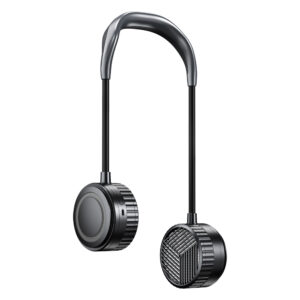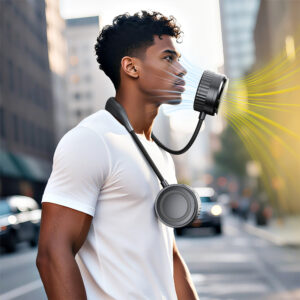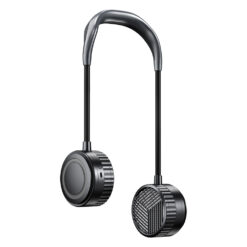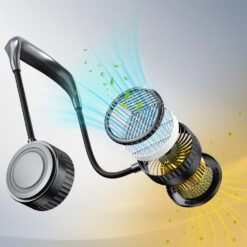In this blog post, dokuki speaks with AirFanta founder and chief engineer Adam to get a deep dive into the development of AirFanta Wear, a new wearable laminar air purifier launching in November 2025 in Singapore.
How things started

AirFanta Wear is the latest addition to the lineup of laminar air purifiers created by AirFanta. Laminar air purifiers from AirFanta are not the same as room air purifiers – they are designed in a small, portable form factor and engineered in a way to deliver clean air to the user’s face through Laminar Flow Technology, even in spaces with bad indoor air quality.
Before AirFanta Wear, two laminar air purifier models were released in the global market – AirFanta 4Lite (a tabletop device) and AirFanta mini (a handheld device). Both of these models, as well as the AirFanta Wear, are powered by Laminar Flow Technology. Unlike standard room air purifiers which deliver turbulent air, the air coming out of laminar air purifiers is meant to be as close to a laminar flow as possible. The end result is a stream of clean air reaching the user’s face.
The idea behind AirFanta Wear was simple – Adam wanted to make something that is hands-free and could be worn and used all day.
He observed that people were not using the AirFanta 4Lite according to instructions (the device should be placed within 30 cm at low speed from the user’s face), which led to the idea of AirFanta mini, a laminar air purifier in a handheld form factor. However, there were some limitations with the device, as the user has to hold it as close as possible to their face.
Realizing these problems led to the development of AirFanta Wear, a hands-free device that could be used all day.
Compared to other products in the AirFanta lineup, AirFanta Wear had the longest development cycle, mainly because it had gone through many revisions.
A long development cycle

It took two years to develop the AirFanta Wear, making it the AirFanta product with longest development cycle to date. For comparison, it took 14 months to develop AirFanta 4Lite and seven months for AirFanta mini.
There are two main reasons behind the long development cycle of AirFanta Wear. The first problem was choosing the correct fan. Both the AirFanta 4Lite and AirFanta mini made use of axial fans available on the market, which helped to reduce the development time.
As for AirFanta Wear, Adam decided that he had to go with a centrifugal fan to reduce the amount of air flow getting “bounced back” from the back of the AirFanta mini’s axial fan. A bespoke centrifugal fan had to be developed from scratch, as there wasn’t one in the market that could fit the AirFanta Wear. Plus, without knowing how big the centrifugal fan was going to be, it wasn’t possible to proceed with designing the other components.
The second problem was making an ergonomic design to ensure that people can comfortably use to enjoy clean air all day. It was no easy feat considering the weight and barycenter of the device. Initially, the battery and other PCB components were going to be stored inside the connecting tube surrounding the user’s neck, making it look larger and placing pressure on the user’s neck. After lots of time reiterating the design, the battery and PCB were shifted to the control pod that rests on the user’s chest.
Trial and error

Lots of blood, sweat, and tears went into the development of AirFanta Wear.
Adam’s priority was making a device that could deliver a high level of personal protection to the user, similar to the AirFanta 4Lite and AirFanta mini. According to AirFanta, the user should position their face within 30 cm of the AirFanta 4Lite when used at low speed (the recommended speed), and “as close as possible” to the AirFanta mini.
As Adam puts it, the issue with delivering clean air that effectively reaches the user’s face with a portable device, is that it’s limited by its size and distance. If the air outlet is too far away from the user’s face, by the time it reaches the user’s face, the percentage of clean air would have been significantly reduced due to turbulence.
AirFanta Wear prototypes originally had their air outlets further away from the user’s face and closer to the neck, which would have resulted in 50% less clean air by the time it reaches the user’s face. In order to combat this problem, he figured that the air outlet had to be positioned closer to the user’s face. Any further away and compromises would have to be made to the size, weight, and price of the device.
Through trial and error, and learning some lessons from AirFanta mini, the air outlet pod on AirFanta Wear was designed to be freely adjustable and easy to position as close to the user’s face as possible. In addition, the air outlet pod can be positioned in three ways, allowing users to enjoy clean air even when eating, drinking, or taking photos.
Many prototypes were produced over the course of the AirFanta Wear’s development, including 3D printed ones that will never see the day of light.
Making improvements over past models

Learning from past experiences and taking into account customer feedback, Adam made significant improvements to the technology powering AirFanta Wear.
One example of this is the centrifugal fan, which is being used in an AirFanta product for the very first time. Centrifugal fans are typically used in FFUs (fan filter units) to provide highly clean air in BSL laboratories and cleanrooms. A bespoke centrifugal fan was designed to fit the form factor of the AirFanta Wear.
Adam says that the centrifugal fan was instrumental in making AirFanta Wear the best device for personal protection, as it brought improvements to the Laminar Flow Technology that delivers clean air to the user’s face, increased the overall battery life, and reduced the amount of noise generated. While it wasn’t difficult to design the centrifugal fan, it took a lot of time.
Other improvements have also been made to improve the lifespan of the product, such as a motor that is much more durable than other models.
Rigorous testing

Making something that works effectively for people has always been a goal for Adam, who had continuously reiterated on the design of the AirFanta Wear to achieve a high level of personal protection.
The chief engineer admitted that he had personally tested the AirFanta Wear on himself dozens of times through a simplified saccharin test.
A saccharin test is a fit test typically used to check whether an N95 respirator fits the face of the user. The user dons a respirator or device that they wish to test, and a nebulizer with a sweet or bitter solution is sprayed onto the user’s face for some time. If they can’t taste the solution, it means that the respirator or device passed the fit test.
All of the saccharin tests conducted by Adam passed with flying colors as he wasn’t able to taste the saccharin solution, proving the effectiveness of the product.
Besides in-house tests, a third-party laboratory tested the effectiveness of the device against the human coronavirus, pine pollen, and Staphylococcus Lentus bacteria. All three tests showed at least 99.9% effectiveness against the three pollutants, matching the results of the in-house saccharin test.
Adam admitted that similar to other devices, he and his family use the AirFanta Wear to reduce their exposure to airborne illnesses such as SARS-Cov2 (COVID-19) and influenza. This desire was what drove him to perfect the AirFanta Wear and rigorously test it during its long development cycle.
Real-world use cases

While AirFanta Wear was conceived as a means for people to improve their protection against airborne diseases such as COVID-19 and influenza, it is highly effective against other types of airborne pollutants too, from allergens to dust.
Adam used his wife as an example, who is very sensitive to smell. Adam’s wife has a very strong sense of smell to the point that she can tell the difference between tap water and filtered tap water. While she doesn’t like to wear a mask, she uses one whenever she rides in a taxi, as she is sensitive to stinky odors in the taxi even though Adam can’t smell them. Ever since a usable AirFanta Wear prototype was developed, he says that “she can’t live without it” anymore.
Get your AirFanta Wear today
AirFanta Wear is now available for purchase on the dokuki official website, launching in November 2025. Click below to buy now.
Laminar Air Purifier



